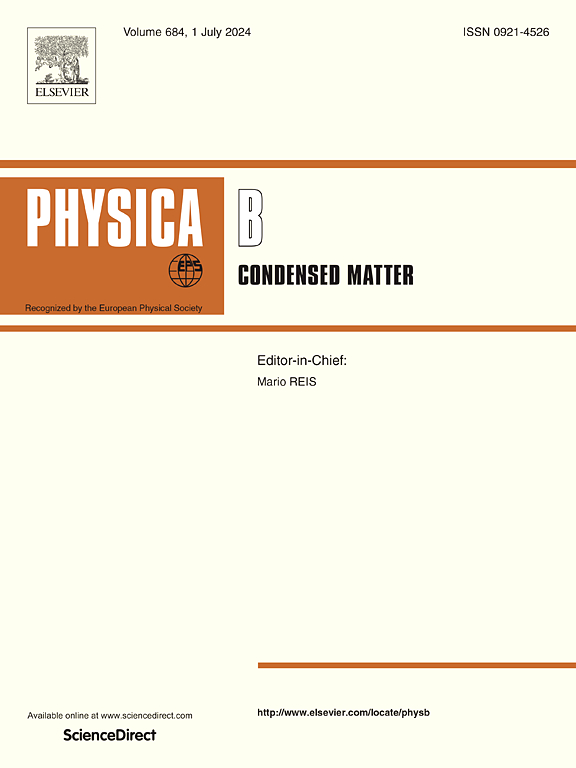掺锌β-Ga2O3的第一性原理研究:电子、光电和热力学性质
IF 2.8
3区 物理与天体物理
Q2 PHYSICS, CONDENSED MATTER
引用次数: 0
摘要
单斜斜β-Ga2O3是一种很有前途的超宽带隙半导体(4.9 eV),可用于电力电子和深紫外光电子学;然而,p型兴奋剂仍然是一个巨大的挑战。利用第一性原理GGA + U计算,我们研究了zn掺杂Ga2O3的位置偏好、结构稳定性以及电子、光学和热力学性质的演变。通过声子色散证实,Zn优先取代具有最低形成能(5.03 eV)的四面体Ga(1),并引起可忽略不计(< 1%)的晶格畸变。Zn取代使带隙从5.17 eV缩小到4.98 eV,并在O-2p、Zn-3d、Ga-4s杂化驱动下在导带最小值处产生完全的自旋极化。差电荷密度和键居分析表明,掺杂后Ga-O共价减弱,离子特性增强。在光学上,锌的掺入使主吸收峰红移,降低了介质响应强度。热力学计算表明,吉布斯自由能降低,热容持续高(300k时约10R),表明热稳定性得到改善。本文章由计算机程序翻译,如有差异,请以英文原文为准。
First-principles investigation of Zn-doped β-Ga2O3: Electronic, optoelectronic, and thermodynamic properties
Monoclinic β-Ga2O3 is a promising ultrawide-bandgap semiconductor (4.9 eV) for power electronics and deep-ultraviolet optoelectronics; however, p-type doping still remains a formidable challenge. Using first-principles GGA + U calculations, we examine the site preference, structural stability, and the evolution of electronic, optical, and thermodynamic properties in Zn-doped Ga2O3. Zn preferentially substitutes tetrahedral Ga(1) with the lowest formation energy (5.03 eV) and induces negligible (<1 %) lattice distortion, confirmed by phonon dispersion. Zn substitution narrows the bandgap from 5.17 eV to 4.98 eV and yields complete spin polarization at the conduction band minimum, driven by O-2p、Zn-3d、Ga-4s hybridization. Differential charge density and bond-population analyses reveal weakened Ga-O covalency and enhanced ionic character upon doping. Optically, Zn incorporation redshifts the main absorption peaks and lowers the dielectric-response intensity. Thermodynamic calculations show reduced Gibbs free energy and sustained high heat capacity (∼10R at 300 K), indicating improved thermal stability.
求助全文
通过发布文献求助,成功后即可免费获取论文全文。
去求助
来源期刊

Physica B-condensed Matter
物理-物理:凝聚态物理
CiteScore
4.90
自引率
7.10%
发文量
703
审稿时长
44 days
期刊介绍:
Physica B: Condensed Matter comprises all condensed matter and material physics that involve theoretical, computational and experimental work.
Papers should contain further developments and a proper discussion on the physics of experimental or theoretical results in one of the following areas:
-Magnetism
-Materials physics
-Nanostructures and nanomaterials
-Optics and optical materials
-Quantum materials
-Semiconductors
-Strongly correlated systems
-Superconductivity
-Surfaces and interfaces
 求助内容:
求助内容: 应助结果提醒方式:
应助结果提醒方式:


